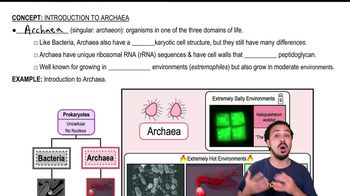Here are the essential concepts you must grasp in order to answer the question correctly.
Archaea Cell Wall Composition
Archaea are a distinct group of microorganisms characterized by their unique cell wall composition. Unlike bacteria, which typically have peptidoglycan in their cell walls, Archaea often contain pseudopeptidoglycan or other polymers, which provide structural integrity and protection. This difference is crucial for understanding the classification and evolutionary relationships among prokaryotes.
Recommended video:
Pseudopeptidoglycan
Pseudopeptidoglycan is a polymer found in the cell walls of many Archaea, serving a similar function to peptidoglycan in bacteria. It consists of N-acetylglucosamine and N-acetyltalosaminuronic acid, which are linked differently than in bacterial peptidoglycan. This unique structure contributes to the resilience of Archaea in extreme environments, highlighting their adaptability.
Differences Between Bacteria and Archaea
Bacteria and Archaea are two distinct domains of life, each with unique cellular structures and biochemical pathways. While both are prokaryotic, they differ in cell wall composition, membrane lipids, and genetic machinery. Understanding these differences is essential for microbiology, as it informs the classification, ecology, and evolutionary biology of these microorganisms.
Recommended video:
 Verified Solution
Verified Solution


 4:39m
4:39m
